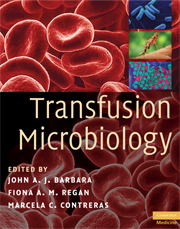Book contents
- Frontmatter
- Contents
- List of contributors
- Foreword
- Preface
- Acknowledgements
- Glossary
- Introduction: Transfusion-transmitted infections, then and now
- Section 1 Agents
- Section 2 Selection and testing
- Section 3 Surveillance, risk and regulation
- 21 Serious hazards of transfusion (SHOT); haemovigilance
- 22 Investigation of post-transfusion infection
- 23 Notification of donors with significant microbiological test results
- 24 Researching the natural history of transfusion-transmitted infections: the UK hepatitis C (HCV) national register
- 25 How to assess risk: prospective studies and calculations
- 26 Risk management
- 27 The regulatory environment in Europe
- 28 Blood safety in developing countries
- Index
- Plate section
- References
25 - How to assess risk: prospective studies and calculations
from Section 3 - Surveillance, risk and regulation
Published online by Cambridge University Press: 12 January 2010
- Frontmatter
- Contents
- List of contributors
- Foreword
- Preface
- Acknowledgements
- Glossary
- Introduction: Transfusion-transmitted infections, then and now
- Section 1 Agents
- Section 2 Selection and testing
- Section 3 Surveillance, risk and regulation
- 21 Serious hazards of transfusion (SHOT); haemovigilance
- 22 Investigation of post-transfusion infection
- 23 Notification of donors with significant microbiological test results
- 24 Researching the natural history of transfusion-transmitted infections: the UK hepatitis C (HCV) national register
- 25 How to assess risk: prospective studies and calculations
- 26 Risk management
- 27 The regulatory environment in Europe
- 28 Blood safety in developing countries
- Index
- Plate section
- References
Summary
Introduction
Assessing, or quantifying, the risk of transfusion-transmission of infection can be attempted by several approaches, each having different costs, advantages and limitations. Surveillance systems, as described in Chapter 21, can monitor diagnosed transfusion-transmitted infections. However, several factors common to transfusion-transmitted infections, and to transfusion recipients, are likely to contribute to a lack of clinically apparent symptoms and therefore to under-diagnosis of infections. For example, other therapies may negate or modify symptoms. Many transfusion recipients are receiving antibiotic drugs and are therefore less likely to suffer observable consequences from bacterial infections. Transfusion recipients may be sick or injured, are often elderly, and have high mortality from other causes. Furthermore, the recipients who receive relatively large numbers of transfusions, and are therefore at the highest risk of transfusion-transmitted infections, have the highest comorbidity and mortality rates. Long pre-symptomatic periods are common for persistent blood-borne virus infections and occurrence of disease may be far removed in time from the transfusion-exposure. This period may be shortened by a relatively large dose of the infectious agent, and in recipients who are older, already ill or immunocompromised. Such characteristics are common amongst transfusion recipients, but even so, transfusion may be overlooked as a possible route of infection due to some delay in diagnosis. For some infections (for example hepatitis A and parvovirus B19), naturally acquired immunity may be quite high – especially in older age groups – meaning that transmission of infection may be considerably less frequent than the number of infectious units of blood transfused.
- Type
- Chapter
- Information
- Transfusion Microbiology , pp. 329 - 340Publisher: Cambridge University PressPrint publication year: 2008
References
- 1
- Cited by



